This is great research on the origins of Santa Claus. And scary stuff too. Santa falls under paganism/demonology, and is the poster boy for consumerism, the madness that manifests itself in the video of Black Friday a few posts down. Time to end Santa's attachment to the remembrance of the birth of the Savior. Fascinating to read here the links of santa to Thor (the Norwegian Apollo), gnomes (demons) and even Satan.
A Curious Amalgam
While undoubtedly Santa Claus was based in part on St Nicholas and the gift giving legends associated with him, the modern day Santa Claus bears remarkable similarities to other sources.
In Germany, St. Nicholas is also known as Klaasbuur, Sunnercla, Burklaas, Bullerklaas, and Rauklas, and in eastern Germany, he is also known as Shaggy Goat, Ash Man and Rider and is more reflective of earlier pagan influences (Norse) that were blended in with the figure of St. Nicholas, when Christianity came to Germany. [13]
 |
| King Winter |
The truth is that St. Nicholas is a blend of many different cultures, customs, legends and mythological
creatures. Consider the similarities to these early legends.
Thor and Odin
9th Century
In 9th century England the Saxons honoured King Winter or King Frost. He would be represented by somebody dressed in a fur hat or crown and would visit their firesides. The Saxons believed that by welcoming Winter as a personage or deity the season would be less harsh to them.
9th & 10th Century
With the arrival of the Vikings in England during the 9th and 10th centuries Odin, their chief god, influenced the Winter gift practices. Odin had twelve characters and the one for December was known as Yalka or Jule and his month was called Jultid from which Yuletide derives. The Vikings believed that Odin visited Earth during Jultid on Sleipnir, his eight-legged horse. He would be disguised in a long blue hooded cloak and carrying a staff and a satchel of bread. His companion was either a Raven or Crow. He was said to join groups around their fire and listen to their conversations to see if they were content. He would sometimes leave the bread as a gift at poor homesteads. [14]
Most Santa researchers agree that some traits of Santa [including the reindeer?] was borrowed from Norse [Scandinavian] mythology.
Prior to the Germanic peoples' Christianization, Germanic folklore contained stories about the god Odin (Wodan), who would each year, at Yule, have a great hunting party accompanied by his fellow gods and the fallen warriors residing in his realm. Children would place their boots, filled with carrots, straw or sugar, near the chimney for Odin's flying horse, Sleipnir, to eat. Odin would then reward those children for their kindness by replacing Sleipnir's food with gifts or candy [Siefker, chap. 9, esp. 171-173]. This practice survived in Germany, Belgium and the Netherlands after the adoption of Christianity and became associated with Saint Nicholas. [15]
Most of the stories originate with in the European culture, primarily that of the Nordic traditions of Northern Europe. The Norse god Odin rode on a white eight legged horse and delivered either presents or punishments. The eight legged horse may be the origins of the eight reindeer that we know of today along with the naughty or nice list is constantly checked. [16]
[Santa Originally had eight reindeer. Rudolph, the ninth reindeer and son of Donner, was the result of a verse written by Robert L. May for Montgomery Ward in 1939 and published as a book to be given to children in the store at Christmas.]
“It is held by some scholars that the legends of Nicholas as gift-giver drew in part from pagan, pre-Christian sources. For example, the Teutonic god of the air, Odin, would ride through the air on a gray horse (named Sleipnir) each Autumn - so did Nicholas; Odin had a long white beard - so did Nicholas; a sheaf of grain was left in the field for Odin's horse - children left a wisp of straw in their shoes for Nicholas.
[McKnight, 24-25, 138-139]
Others claim that attributes of the Germanic god Thor, the god of thunder, were transferred to Nicholas. Thor was supposedly elderly and heavy with a long white beard; he road through the air in a chariot drawn by two white goats (called
Cracker and Gnasher); he dressed in red; his palace was in the "northland;" he was friendly and cheerful; he would come down the chimney into his element, the fire. [17]
No definitive correlation has ever been found between the "visit of St. Nicholas" and pagan gods such as Odin and Thor. However the similarity is striking and some relationship seems likely”. [18] Emphasis Added]
Encyclopedia Britannica describes the role of Nordic mythology in the life of Santa:
Sinterklaas was adopted by the country's English-speaking majority under the name Santa Claus, and his legend of a kindly old man was united with old Nordic folktales of a magician who punished naughty children and rewarded good children with presents. [19]
Some Santa researchers associate Santa with the Norse "god" of Odin or Woden. Crichton describes Odin as riding through the sky on an eight-legged, white horse name Sleipnir. (Santa originally had eight reindeers, Rudolph was nine). Odin lived in Valhalla (the North) and had a long white beard. Odin would fly through the sky during the winter solstice (December 21-25) rewarding the good children and punishing the naughty. [20]
Mythologist Helene Adeline Guerber presents a very convincing case tracing Santa to the Norse god Thor in Myths of Northern Lands: [Thor being a son of Odin with Thursday (Thor’s Day) being named after him. [21].
Thor was the god of the peasants and the common people. He was represented as an elderly man, jovial and friendly, of heavy build, with a long white beard. His element was the fire, his color red. The rumble and roar of thunder were said to be caused by the rolling of his chariot, for he alone among the gods never rode on horseback but drove in a chariot drawn by two white goats (called Cracker and Gnasher). He was fighting the giants of ice and snow, and thus became the Yule-god. He was said to live in the "Northland" where he had his palace among icebergs. By our pagan forefathers he was considered as the cheerful and friendly god, never harming the humans but rather helping and protecting them. The fireplace in every home was especially sacred to him, and he was said to come down through the chimney into his element, the fire. [22]
In the Handbook of Christian Feasts and Customs, author Francis Weiser traces the origin of Santa to Thor:
After listing some the common attributes of Thor and Santa, Weiser concludes:
Here, [Thor] then, is the true origin of our "Santa Claus." . . . With the Christian saint whose name he still bears, however, this Santa Claus has really nothing to do. [24]
In the words of Dr. Terry Watkins in Santa Claus The Great Imposter … “The unusual and common characteristics of Santa and Thor are too close to ignore.
- An elderly man, jovial and friendly and of heavy build.
- With a long white beard.
- His element was the fire and his color red.
- Drove a chariot drawn by two white goats, named called Cracker and Gnasher.
- He was the Yule-god. (Yule is Christmas time).
- He lived in the Northland (North Pole).
- He was considered the cheerful and friendly god.
- He was benevolent to humans.
- The fireplace was especially sacred to him.
- He came down through the chimney into his element, the fire”.
The Tomte/Nisse
The tomte/nisse is a mythical creature of Scandinavian folklore originating from Norse paganism and in ancient times was believed to be the "soul" of the first inhabitor of the farm. The tomte/nisse was usually described as a short man (under four feet tall) wearing a red cap with a tassel. Nisse were believed to take care of a farmer’s home and children and protect them from misfortune, in particular at night, when the house folk were asleep. Despite his smallness, the tomte/nisse possessed an immense strength. Even though he was protective and caring he was easy to offend, and his retributions ranged from a stout box on the ears to the killing of livestock or ruining of the farm’s fortune. A particular gift was a bowl of porridge on Christmas night. If he wasn’t given his payment, he would leave the farm or house, or engage in mischief such as tying the cows’ tails together in the barn, turning objects upside-down, and breaking things. The tomte was not always a popular figure: Like most creatures of folklore he would be seen as heathen and become connected to the Devil and having a tomte on the farm meant you put the fate of your soul at risk.
In the English editions of the fairy tales of H. C. Andersen the word nisse has been inaccurately translated as "goblin". A more accurate translation is "brownie"... the Scottish counterpart of the Scandinavian tomte. Since there is a Tomtar & Troll shop in Stockholm Sweden, I assume Tomtar is closely related to a Troll.
In the 1840s the farm's "nisse" became the bearer of Christmas presents in Denmark, and was then called "julenisse". In 1881, the Swedish magazine
Ny Illustrerad Tidning published Viktor Rydberg's poem
Tomten, where the tomte is alone awake in the cold Christmas night, pondering the mysteries of life and death. This poem featured the first painting by Jenny Nyström of this traditional Swedish mythical character which she turned into the white-bearded, red-capped friendly figure associated with Christmas ever since. Shortly afterwards, and obviously influenced by the emerging Father Christmas traditions as well as the new Danish tradition, a variant of the tomte/nisse, called the "jultomte" in Sweden and "julenisse" in Norway, started bringing the Christmas presents in Sweden and Norway, instead of the traditional
julbock Yule Goat. [25]

Jenny Nyström is mainly known as the person who created the Swedes’ image of the “jultomte” on numerous Christmas cards and magazine covers [illustration on the right], thus linking the Swedish version of Santa Claus to the gnomes of Scandinavian folklore. [26]
The Jultomten brings gifts in a sleigh driven by the goats of Thor..
Swedish children wait eagerly for Jultomten, a gnome whose sleigh is drawn by the Julbocker, the goats of the thunder god Thor. With his red suit and cap, and a bulging sack on his back, he looks much like the American Santa Claus. [27]
In some areas of Sweden, Jultmoten the Gift-Bringer is a gnome whose sleigh is drawn by the Julbocker, goats which are the property of Thor, God of Thunder. Julmoten dresses in red and carries a b
ulging sack upon his back. [28] Emphasis Added].
The Long Leap
It has been oft claimed that Santa Claus was introduced to America by the Dutch, who settled in what was known as New Amsterdam.. now New York. Apparently this story is without much, if any merit. The St, Nicholas center tells us that….[All Emphasis Added]
Although it is nearly universally reported that the Dutch did bring St. Nicholas to New Amsterdam [Now New York], scholars find limited evidence of such traditions in Dutch New Netherland. Colonial Germans in Pennsylvania held the feast of St. Nicholas, and several accounts do have St. Nicholas visiting New York Dutch on New Years' Eve. [29]
This was not a saintly bishop, rather an elfin Dutch burgher with a clay pipe. These delightful flights of imagination are the origin of the New Amsterdam St. Nicholas legends: that the first Dutch emigrant ship had a figurehead of St. Nicholas; that St. Nicholas Day was observed in the colony; that the first church was dedicated to him; and that St. Nicholas comes down chimneys to bring gifts. Irving's work was regarded as the "first notable work of imagination in the New World." [29]
Other Sources [All Emphasis Added ]
The claim that Dutch settlers, in 1626 introduced Sinter Claes to New Amsterdam (to be New York) is an invention of Washington Irving (History of New York, started in 1809). Charles W. Jones states (1954, Knickerbocker Santa Claus, New York Historical Society Quarterly, Vol. 38, No. 4, pp. 357-383, see pp. 367-71) that no documentary evidence has ever been found of a Dutch Santa Claus cult in New Amsterdam or in the [pre-1773, BKS, see below] British colonial period in New York. The settlers of New Amsterdam were Protestants, not Catholics, with little St. Nicholas tradition. [30]
Nearly everyone repeats this story [the Dutch-Santa]. . . But when we look at the evidence—that is, the newspapers, magazines, diaries, books, broadsides, music, sculpture, and merchandise of past times, the picture is not substantiated. [31]
There is no evidence that it [Santa Claus] existed in New Amsterdam, or for a century after occupation. . . ([31]
I have not found evidence of St. Nicholas in any form—in juveniles or periodicals or diaries—in the period of Dutch rule, or straight through the seventeenth and eighteenth centuries to the year 1773. [31]
Years of research confirmed that initial doubt: Santa Claus is an Americanization, all right, but not of a Catholic Saint. . . Despite a century of repetition, this story is simply untrue. . . [32]
The dilemma was solved by transferring the visit of the mysterious man whom the Dutch called Santa Claus from December 5 to Christmas, and by introducing a radical change in the figure itself. It was not merely a "disguise," but the ancient saint was completely replaced by an entirely different character. . .With the Christian saint whose name he still bears, however this Santa Claus has really nothing to do. [33]

The truth is that the modern day Santa Claus bears little resemblance to the Catholic Saint and has almost enti
rely replaced him.
The Development of Santa Claus in America
The following is a short summation of the development of Santa Claus in America..
In 1804, the New York Historical Society was founded with Nicholas as its patron saint, its members reviving the Dutch tradition of St. Nicholas as a gift-bringer. In 1809, Washington Irving published his satirical A History of New York, by one "Diedrich Knickerbocker," a work that poked fun at New York's Dutch past (St. Nicholas included). When Irving became a member of the Society the following year, the annual St. Nicholas Day dinner festivities included a woodcut of the traditional Nicholas figure (tall, with long robes) accompanied by a Dutch rhyme about "Sancte Claus" (in Dutch, "Sinterklaas"). Irving revised his History of New York in 1812, adding details about Nicholas' "riding over the tops of the trees, in that selfsame waggon wherein he brings his yearly presents to children." [14]
Two quotes from Washington Irving’s A History of New York
And the sage Oloffe dreamed a dream,–and lo, the good St. Nicholas came riding over the tops of the trees, in that self-same wagon wherein he brings his yearly presents to the children. . . And when St. Nicholas had smoked his pipe, he twisted it in his hatband, and laying his finger beside his nose, gave the astonished Van Kortlandt a very significant look; then, mounting his wagon, he returned over the treetops and disappeared. [34]
At this early period was instituted that pious ceremony, still religiously observed in all our ancient families of the right breed, of hanging up a stocking in the chimney on St. Nicholas Eve; which stocking is always found in the morning miraculously filled; for the good St. Nicholas has ever been a great giver of gifts, particularly to children. [35]
“In 1821, a New York printer named William Gilley issued a poem about a "Santeclaus" who dressed all in fur and drove a sleigh pulled by one reindeer. Gilley's "Sante," however, was very short.
On Christmas Eve of 1822, another New Yorker, Clement Clarke Moore, wrote down and read to his children a series of verses; his poem was published a year later as "An Account of a Visit from St. Nicholas" (more commonly known today by its opening line, "'Twas the night before Christmas . . ."). Moore gave St. Nick eight reindeer (and named them all), and he devised the now-familiar entrance by chimney. Moore's Nicholas was still a small figure, however -- the poem describes a "miniature sleigh" with a "little old driver."
In 1863, a caricaturist for Harper's Weekly named Thomas Nast began developing his own image of Santa.

Nast gave his figure a "flowing set of whiskers" and dressed him "all in fur, from his head to his foot." Nast's 1866 montage entitled "Santa Claus and His Works" established Santa as a maker of toys; an 1869 book of the same name collected new Nast drawings with a poem by George P. Webster that identified the North Pole as Santa's home. Although Nast never settled on one size for his Santa figures (they ranged from elf-like to man-sized), his 1881 "Merry Old Santa Claus" drawing is quite close to the modern-day image”. “ [14]
Harper’s Weekly online provides a little more insight.
While setting the national standard, Nast’s own depiction of Santa Claus changed over the years. He began his almost-annual contribution of Christmas illustrations when he joined the staff of Harper’s Weekly in 1862 during the Civil War. [Nast contributed 33 Christmas drawings to Harper’s Weekly from 1863 through 1886, and Santa is seen or referenced in all but one. His first Santa (in the postdated January 3, 1863 issue) is a small elf distributing Christmas presents to Union soldiers in camp. [36]
From 1866-1871, Nast continued to elaborate upon the image of Santa Claus portrayed in “Santa and His Works.” As in the featured cartoon, he also emphasized during this period Santa’s disciplinary role in judging whether the behavior of children during the past year warranted Christmas rewards or punishment. In an 1870 cartoon, Santa surprises two naughty children by jumping out as a jack-in-the-box clutching a switch for spanking. In 1871, Santa sits at his desk reading letter from parents chronicling their children’s good and bad acts, with the “letters from naughty children’s parents” far outnumbering the “letters from good children’s parents.” [36].
Incidentally the tradition of decorating a Christmas Tree originated in Germany, and arrived on American shores in the ‘40’s. Time Magazine reported..
“even before the arrival of Christianity, Germans decorated evergreen trees to brighten the dark, gloomy days of the winter solstice. The first "Christmas trees" appeared in Strasbourg in the 17th century and spread to Pennsylvania in the 1820s with the arrival of German immigrants. When Queen Victoria married Germany's Prince Albert in 1840, he brought the tradition to England. Eight years later, the first American newspaper ran a picture of the royal Christmas tree and Americans outside of Pennsylvania quickly followed.” [36b]
Santa’s Companion
This section is almost entirely excerpted from Santa Claus The Great Imposter by Dr. Terry Watkins.)
There is a little-known piece in the life of Santa that time and tradition has silently erased. Few people are aware that for most of his life, St. Nicholas (Sinter Klaas, Christkind, et. al.) had an unusual helper or companion. This mysterious sidekick had many names or aliases. He was known as Knecht Rupprecht;

Pelznickle; Ru-Klas;
Swarthy; Dark One; Dark Helper; Black Peter; Hans Trapp; Krampus; Grampus; Zwarte Piets; Furry Nicholas; Rough Nicholas; Schimmelreiter; Klapperbock; Julebuk; et. al.
Though his name changed, he was always there. Some other well known titles given to St. Nick’s bizarre companion is a demon, evil one, the devil and Satan. One of his dark duties was to punish children and "gleefully drag them to hell."
The following references are provided to demonstrate the "devil" who accompanies St. Nicholas is a well documented fact. In every forerunner of Santa this dark and diabolic character appears.
It is the Christkind who brings the presents, accompanied by one of its many devilish companions, Knecht Ruprecht, Pelznickle, Ru-Klas. . . [37]
In many areas of Germany, Hans Trapp is the demon who accompanies Christkind on its gift-giving round. . . [38]
Another Christmas demon from lower Austria, Krampus or Grampus, accompanies St. Nicholas on December 6. [39]
Like Santa, Sinterklaas and the Dark Helper were also supposed to have the peculiar habit of entering homes through the chimney. . . [40]
In Sarajevo in Bosnia, Saint Nickolas appears with gifts for the children in spite of the war and shelling. He is assisted by a small black devil who scares the children. [41]
Ruprecht here plays the part of bogeyman, a black, hairy, horned, cannibalistic, stick-carrying nightmare. His role and character are of unmitigated evil, the ultimate horror that could befall children who had been remiss in learning their prayers and doing their lessons. He was hell on earth. [42]
In Holland, Sinterklaas (Santa Claus) wore a red robe while riding a white horse and carried a bag of

gifts to fill the children's stockings.
A sinister assistant called Black Pete proceeded Sinterklaas in the Holland tradition to seek out the naughty boys and girls who would not receive gifts. [43]
The Christian figure of Saint Nicholas replaced or incorporated various pagan gift-giving figures such as the Roman Befana and the Germanic Berchta and Knecht Ruprecht. . . He was depicted wearing a bishop's robes and was said to be accompanied at times by Black Peter, an elf whose job was to whip the naughty children. [44]
Christmas historian Miles Clement relates that no "satisfactory account has yet been given" to the origins of these demons and devils that appear with St. Nicholas.
It can hardly be said that any satisfactory account has yet been given of the origins of this personage, or of his relation to St. Nicholas, Pelzmarte, and monstrous creatures like the Klapperbock. [45]
Maybe a satisfactory account has been given. Let us keep reading.
Previously, we established the peculiar fact that today’s Santa Claus and St. Nicholas are not the same. They never have been. Santa Claus is dressed in a long shaggy beard, furs, short, burly and obese. The legends of St. Nicholas portrayed a thin, tall, neatly dressed man in religious apparel. You could not possibly find two different characters.
If Nicholas, the ascetic bishop of fourth-century Asia Manor, could see Santa Claus, he would not know who he was. [46]
So the legends of Saint Nicholas afford but a slight clue to the origin of Santa Klaus,–alike, indeed, in name but so unlike in all other respects. [47]
The Model For Nast’s Santa..
The startling fact is, Santa Claus is not the Bishop St. Nicholas – but his Dark Helper!
In certain German children’s games, the Saint Nicholas figure itself is the Dark Helper, a devil who wants to punish children, but is stopped from doing so by Christ. [48]
Black Pete, the ‘grandfather’ of our modern Santa Claus. Known in Holland as Zwarte Piet, this eighteenth-century German version, is—like his ancient shamanic ancestor—still horned, fur-clad, scary, and less than kind to children. Although portrayed as the slave helper of Saint Nicholas, the two are, in many villages, blended into one character. This figure often has the name Nikolass or Klaus, but has the swarthy appearance of the Dark Helper. [49]
Artist Thomas Nast is rightfully credited for conceiving the image of our modern day Santa, but Nast’s model for Santa was not the Bishop St. Nicholas but his dark companion, the evil Pelznickle.
[IPS Note: Nast was an immigrant from Bavaria and was familiar with Pelznickle]
The Christmas demon Knecht Rupprecht first appeared in a play in 1668 and was condemned by the Roman Catholic as being a devil in 1680. . . To the Pennsylvania Dutch, he is known as Belsnickel. Other names for the same character are Pelznickle, "Furry Nicholas," and Ru-Klas, "Rough Nicholas." From these names, it is easy to see that he is looked upon as not merely a companion to St. Nicholas, but almost another version of him. [50]
In Thomas Nast: His Period and His Pictures, biographer Albert Bigelow Paine, documents that Nast’s Santa was Pelznickle.
But on Christmas Eve, to Protestant and Catholic alike, came the German Santa Claus, Pelze-Nicol, leading a child dressed as the Christkind, and distributing toys and cakes, or switches, according as the parents made report. It was this Pelze-Nicol – a fat, fur-clad, bearded old fellow, at whose hands he doubtless received many benefits – that the boy in later years was to present to us as his conception of the true Santa Claus – a pictorial type which shall lone endure. [51]
Santa historian and author, Tony van Renterghem also documents Nast’s Santa Claus was not Saint Nicholas, but the evil Black Pete–the devil.
Thomas Nast was assigned to draw this Santa Claus, but having no idea what he looked like, drew him as the fur-clad, small, troll-like figure he had known in Bavaria when he was a child. This figure was quite unlike the tall Dutch Sinterklaas, who was traditionally depicted as a Catholic bishop. Who he drew was Saint Nicholas’ dark helper, Swarthy, or Black Pete (a slang name for the devil in medieval Dutch). . . [52]
Santa researcher, Phyllis Siefker, echoes Renterghem’s conclusion:
It seems obvious, therefore, that Santa Claus can be neither the alter ego of Saint Nicholas nor the brainchild of Washington Irving. . . If we peek behind the imposing Saint Nicholas, we see, glowering in the shadows, the saint’s reprobate companion, Black Pete. He, like Santa, has a coat of hair, a disheveled beard, a bag, and ashes on his face. . . In fact, it is this creature, rather than Irving’s creation or an Asian saint, who fathered Santa Claus. [53]
By the way, St. Nicholas did not come down the chimney. It was his fur-clad, dark companion that came down the chimney. One of the reasons his sidekick was called the "Dark One" or "Black Peter" was because he was normally covered in soot and ashes from his chimney travels. The "dark companion" also carried the bag, distributed the goodies and punished the bad boys and girls.
Children [in Holland] are told that Black Peter enters the house through the chimney, which also explained his black face and hands, and would leave a bundle of sticks or a small bag with salt in the shoe instead of candy when the child had been bad. [54]

It is significant that Black Peter, Pelze-Nicol, Knecht Rupprecht and all of St. Nicholas companions are openly identified as the devil.
To the medieval Dutch, Black Peter was another name for the devil. Somewhere along the way, he was subdued by St. Nicholas and forced to be his servant. [55]
In Denmark, Sweden, and Norway creatures resembling both the Schimmelreiter and the Klapperbock are or were to be met with at Christmas. . . People seem to have had a bad conscience about these things, for there are stories connecting them with the Devil. A girl, for instance, who danced at midnight with a straw Julebuk, found that her partner was no puppet but the Evil One himself. 56]
Thus, in parts of Europe, the Church turned Herne into Saint Nicholas’ captive, chained Dark Helper, none other than Satan, the Dark One, symbolic of all evil. [57]
One of the bizarre jobs of St. Nick’s devilish helper was to "gleefully drag sinners" to hell!

On the eve of December 6, the myth told that this bearded, white-haired old ‘saint,’ clad in a wide mantel, rode through the skies on a white horse, together with his slave, the swarthy Dark Helper. This reluctant helper had to disperse gifts to good people, but much preferred to threaten them with his broom-like scourge, and, at a sign of his master, would gleefully drag sinners away to a place of eternal suffering. [58]
The shocking truth is Santa Claus originated from a character identified as the devil or
Satan.
Read more at -
http://www.inplainsite.org/html/santa_claus.html#Popularity
Notes:
[13] Anise Hollingshead. St. Nicholas: The Story of Santa Clause.
http://holidays.kaboose.com/christmas/traditions/st-nicholas/xmas-around-stnicholas.html
[14] http://www.time4me.com/card/legend/SantaClaus.html
[15] http://www.statemaster.com/encyclopedia/Santa-Claus [16]
[16] Diana Tierney. Jolly Old Saint Nicholas The evolution of an Icon http://folktalesmyths.suite101.com/article.cfm/jolly_old_saint_nicholas
[17] Francis X. Weiser, Handbook of Christian Feasts and Customs. New York: Harcourt, Brace, and Company, 1958, 113-114
[18] Dr. Richard P. Bucher. The Origin of Santa Claus and the Christian Response to Him.
[19] "Santa Claus" Encyclopaedia Britannica 99. As Quoted in Santa Claus The Great Imposter by Dr. Terry Watkins.
[20] Crichton, Robin. Who is Santa Claus? The Truth Behind a Living Legend. Bath: The Bath Press, 1987, pp. 55-56. As Quoted in Santa Claus The Great Imposter by Dr. Terry Watkins.
[21] As Quoted in Santa Claus The Great Imposter by Dr. Terry Watkins
[22] Guerber, H.A. Myths of Northern Lands. New York: American Book Company, 1895, p. 61
[23] Weiser, Francis X. Handbook of Christian Feasts and Customs. New York: Harcourt, Brace & World, Inc., 1952, p. 113
[24] Ibid. p. 114
[25] http://en.wikipedia.org/wiki/Tomte
[26] http://en.wikipedia.org/wiki/Jenny_Nystr%C3%B6m
[27] Barth, Edna. Holly, Reindeer, and Colored Lights, The Story of the Christmas Symbols. New York: Clarion Books, 1971, p. 49. As Quoted in Santa Claus The Great Imposter by Dr. Terry Watkins.
[28] http://www.novareinna.com/festive/gift.html
[29] St. Nicholas Center. Saint Nicholas and the Origin of Santa Claus. http://www.stnicholascenter.org/Brix?pageID=35
[30] B. K. Swartz, Jr. The Origin Of American Christmas Myth And Customs. http://www.bsu.edu/web/01bkswartz/xmaspub.html
[31] Jones, Charles. W. "Knickerbocker Santa Claus." The New-York Historical Society Quarterly, October 1954, Volume XXXVIII Number Four, p. 362. As Quoted in Santa Claus The Great Imposter by Dr. Terry Watkins.
[32] Siefker, Phyllis. Santa Claus, Last of the Wild Men: The Origins and Evolution of Saint Nicholas. Jefferson: McFarland & Company, Inc., 1997, pp. 5,7. As Quoted in Santa Claus The Great Imposter by Dr. Terry Watkins.
[33] Weiser, Francis X. Handbook of Christian Feasts and Customs. New York: Harcourt, Brace & World, Inc., 1952, p. 114. As Quoted in Santa Claus The Great Imposter by Dr. Terry Watkins.
[34] Irving, Washington. A History Of New York From The Beginning Of The World To The End Of The Dutch Dynasty: Paperback edition (2004) from Kessinger Publishing. p. 88-89
[35] Ibid. p. 98
[36] Robert C. Kennedy. Santa Claus and His Works.
http://www.harpweek.com/09Cartoon/BrowseByDateCartoon.asp?Month=December&Date=25
[36b] http://www.time.com/time/specials/packages/article/0,28804,1868506_1868508_1868530,00.html
[37] Del Re, Gerard and Patricia. The Christmas Almanack. New York: Random House, 2004, p. 70
[38]Ibid p. 75
[39] Ibid p. 94
[40] Renterghem, Tony van. When Santa Was a Shaman. St. Paul: Llewellyn Publications, 1995, p. 102
[41] Ibid Renterghem, Tony van. When Santa Was a Shaman. St. Paul: Llewellyn Publications, 1995, p. 102
[42] Siefker, Phyllis. Santa Claus, Last of the Wild Men: The Origins and Evolution of Saint Nicholas. Jefferson: McFarland & Company, Inc., 1997, p. 155
[43] "History of Santa Claus," www.christmas-decorations-gifts-store.com/history_of_santa.htm?
[44] "Santa Claus" Microsoft Encarta Encyclopedia 99)
[45] Miles, Clement A. Christmas in Ritual and Tradition Christian and Pagan. New York: Frederick A. Stokes Company, 1912, p. 232
[46] Del Re, Gerard and Patricia. The Christmas Almanack. New York: Random House, 2004, pp. 138,141
[47] Walsh, William S. The Story of Santa Klaus. Detroit: Gale Research Company, 1970, p. 54
[48] Renterghem, Tony van. When Santa Was a Shaman. St. Paul: Llewellyn Publications, 1995, p. 105
[49] Ibid p. 98
[50] Del Re, Gerard and Patricia. The Christmas Almanack. New York: Random House, 2004, pp. 93,94
[51] Paine, Albert Bigelow. Thomas Nast: His Period and His Pictures. New York: Chelsea House, 1980, p. 6
[52] Renterghem, Tony van. When Santa Was a Shaman. St. Paul: Llewellyn Publications, 1995, pp. 95-96
[53] Siefker, Phyllis. Santa Claus, Last of the Wild Men: The Origins and Evolution of Saint Nicholas. Jefferson: McFarland & Company, Inc., 1997, p. 15
[54] "Saint Nicholas," Wikipedia Encyclopedia. < en.wikipedia.org/wiki/Saint_Nicholas>
[55] Del Re, Gerard and Patricia. The Christmas Almanack. New York: Random House, 2004, p. 44
[56] Miles, Clement A. Christmas in Ritual and Tradition Christian and Pagan. New York: Frederick A. Stokes Company, 1912, p. 202
[57] Renterghem, Tony van. When Santa Was a Shaman. St. Paul: Llewellyn Publications, 1995, p. 97
[58] Renterghem, Tony van. When Santa Was a Shaman. St. Paul: Llewellyn Publications, 1995, p. 111

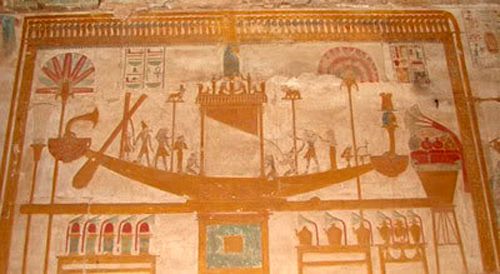
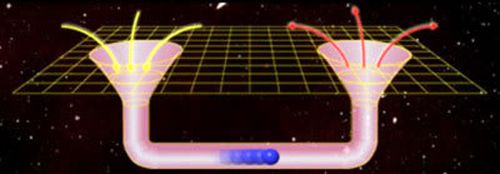










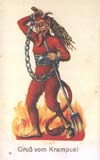 known by many names across the continent — Knecht Ruprecht, Certa, Perchten, Black Peter, Schmutzli, Pelznickel, Klaubauf, and Krampus. Usually seen as a classic devil with horns, cloven hooves and monstrous tongue, but can also be spotted as a sinister gentleman dressed in black or a hairy man-beast. Krampus punishes the naughty children, swatting them with switches and rusty chains before dragging them in baskets to a fiery place below.
known by many names across the continent — Knecht Ruprecht, Certa, Perchten, Black Peter, Schmutzli, Pelznickel, Klaubauf, and Krampus. Usually seen as a classic devil with horns, cloven hooves and monstrous tongue, but can also be spotted as a sinister gentleman dressed in black or a hairy man-beast. Krampus punishes the naughty children, swatting them with switches and rusty chains before dragging them in baskets to a fiery place below.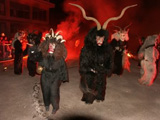 Krampus is celebrated on Krampusnacht, which takes place on the eve of St. Nicholas’ Day. In Austria, Northern Italy and other parts of Europe, party-goers masquerade as devils, wild-men, and witches to participate in Krampuslauf (Krampus Run). Intoxicated and bearing torches, costumed devils caper and carouse through the streets terrifying child and adult alike. Krampusnacht is increasingly being celebrated in other parts of Europe such as Finland and France, as well as in many American cities.
Krampus is celebrated on Krampusnacht, which takes place on the eve of St. Nicholas’ Day. In Austria, Northern Italy and other parts of Europe, party-goers masquerade as devils, wild-men, and witches to participate in Krampuslauf (Krampus Run). Intoxicated and bearing torches, costumed devils caper and carouse through the streets terrifying child and adult alike. Krampusnacht is increasingly being celebrated in other parts of Europe such as Finland and France, as well as in many American cities.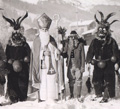 The European practice of mummery during the winter solstice season can be traced back tens of thousands of years. Villagers across the continent dress up as animals, wild-men and mythic figures to parade and perform humorous plays. This ancient guising and masking tradition continues to this day as the primary source for our modern Halloween with its costumes, trick-or-treat, and pagan symbolism. Among the most common figures in these folk rituals were Old Man Winter and the horned Goat-Man — archetypes now found in the forms of Saint Nick/Santa Claus, and the Devil (‘Old Nick’), aka Krampus.
The European practice of mummery during the winter solstice season can be traced back tens of thousands of years. Villagers across the continent dress up as animals, wild-men and mythic figures to parade and perform humorous plays. This ancient guising and masking tradition continues to this day as the primary source for our modern Halloween with its costumes, trick-or-treat, and pagan symbolism. Among the most common figures in these folk rituals were Old Man Winter and the horned Goat-Man — archetypes now found in the forms of Saint Nick/Santa Claus, and the Devil (‘Old Nick’), aka Krampus. 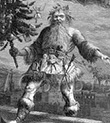 In 19th century New York City an American St. Nick emerged in the form of Santa Claus. Although based on the Dutch Saint Nicholas, Santa incorporated more elements from pagan winter solstice customs. He relinquished his white bishop garb for a red suit, traded his horse and staff for a sleigh and reindeer, and moved his franchise to Christmas Eve.
In 19th century New York City an American St. Nick emerged in the form of Santa Claus. Although based on the Dutch Saint Nicholas, Santa incorporated more elements from pagan winter solstice customs. He relinquished his white bishop garb for a red suit, traded his horse and staff for a sleigh and reindeer, and moved his franchise to Christmas Eve. Santa also tried to take over the dark companion’s job of punishing the naughty, but his New World temperament was apparently unsuited for the task. As Santa neglected and abandoned his punishing duties, American kids lost all fear of Santa and his lumps of coal. Thankfully, in the 21st century, Krampus has arrived in this land of spoiled and dissatisfied children to pick up the slack.
Santa also tried to take over the dark companion’s job of punishing the naughty, but his New World temperament was apparently unsuited for the task. As Santa neglected and abandoned his punishing duties, American kids lost all fear of Santa and his lumps of coal. Thankfully, in the 21st century, Krampus has arrived in this land of spoiled and dissatisfied children to pick up the slack.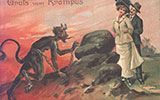 While Santa Claus expanded shop and sold products in mid-1800s America, the holiday card craze exploded in Europe.
While Santa Claus expanded shop and sold products in mid-1800s America, the holiday card craze exploded in Europe.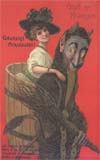 In Austria and other parts of Europe, countless season’s greeting cards featured Krampus, often emblazoned with the phrase “Grüß Vom Krampus” (Greetings from Krampus). While the lurid images are suffused with a modern sense of the comic and the surreal, they still resonant with mythic power and primordial horror.
In Austria and other parts of Europe, countless season’s greeting cards featured Krampus, often emblazoned with the phrase “Grüß Vom Krampus” (Greetings from Krampus). While the lurid images are suffused with a modern sense of the comic and the surreal, they still resonant with mythic power and primordial horror. 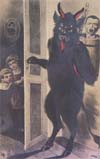 And with Krampus representing the naughty side of the season, the sexy subtext is hard to ignore in these often very cheeky cards. A century later, the brilliance of these magnificent works of pop art is now gaining global recognition.
And with Krampus representing the naughty side of the season, the sexy subtext is hard to ignore in these often very cheeky cards. A century later, the brilliance of these magnificent works of pop art is now gaining global recognition.



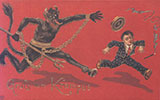 A new appreciation of ancient traditions that smoulder in the dark recesses of holiday revelry continues to rise around the world. Krampus, with his horns, hoove and tongue, embodies this revived spirit of the Xmas season!
A new appreciation of ancient traditions that smoulder in the dark recesses of holiday revelry continues to rise around the world. Krampus, with his horns, hoove and tongue, embodies this revived spirit of the Xmas season!

 It is significant that Black Peter, Pelze-Nicol, Knecht Rupprecht and all of St. Nicholas companions are openly identified as the devil.
It is significant that Black Peter, Pelze-Nicol, Knecht Rupprecht and all of St. Nicholas companions are openly identified as the devil. 


 name of Kriss Kringle which is German for "little Christ Child".
name of Kriss Kringle which is German for "little Christ Child". friendly elf:
friendly elf: 



 Nast gave his figure a "flowing set of whiskers" and dressed him "all in fur, from his head to his foot." Nast's 1866 montage entitled "Santa Claus and His Works" established Santa as a maker of toys; an 1869 book of the same name collected new Nast drawings with a poem by George P. Webster that identified the North Pole as Santa's home. Although Nast never settled on one size for his Santa figures (they ranged from elf-like to man-sized), his 1881 "Merry Old Santa Claus" drawing is quite close to the modern-day image”. “ [14]
Nast gave his figure a "flowing set of whiskers" and dressed him "all in fur, from his head to his foot." Nast's 1866 montage entitled "Santa Claus and His Works" established Santa as a maker of toys; an 1869 book of the same name collected new Nast drawings with a poem by George P. Webster that identified the North Pole as Santa's home. Although Nast never settled on one size for his Santa figures (they ranged from elf-like to man-sized), his 1881 "Merry Old Santa Claus" drawing is quite close to the modern-day image”. “ [14] Pelznickle; Ru-Klas; Swarthy; Dark One; Dark Helper; Black Peter; Hans Trapp; Krampus; Grampus; Zwarte Piets; Furry Nicholas; Rough Nicholas; Schimmelreiter; Klapperbock; Julebuk; et. al.
Pelznickle; Ru-Klas; Swarthy; Dark One; Dark Helper; Black Peter; Hans Trapp; Krampus; Grampus; Zwarte Piets; Furry Nicholas; Rough Nicholas; Schimmelreiter; Klapperbock; Julebuk; et. al.  gifts to fill the children's stockings. A sinister assistant called Black Pete proceeded Sinterklaas in the Holland tradition to seek out the naughty boys and girls who would not receive gifts. [43]
gifts to fill the children's stockings. A sinister assistant called Black Pete proceeded Sinterklaas in the Holland tradition to seek out the naughty boys and girls who would not receive gifts. [43]

